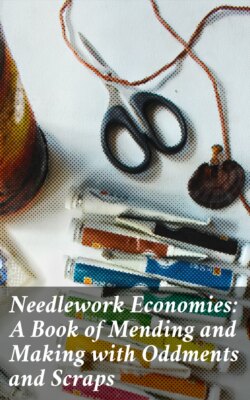Читать книгу Needlework Economies: A Book of Mending and Making with Oddments and Scraps - Группа авторов - Страница 11
На сайте Литреса книга снята с продажи.
Utilizing Partly-Worn Garments.
ОглавлениеTable of Contents
Garments are often discarded as being of no use, just because they are worn in certain parts, whereas a little thought and careful cutting will often transform them into something quite useful. It is often possible, for instance, to make garments for the little ones by using the least worn portions of larger sized clothes. Partly worn woollen vests can be admirably re-made into babies’ pants.
To make these take the old vest and cut along the line A B, shown on the little diagram. This cuts away the most worn part of the garment. Curve out at the bottom, along the lines C D and E F.
The stitches required in the little garments are very simple. Join by seaming together the edges from D to E. Turn down a fold of about ½-inch round the curved portions, and herringbone or machine-stitch. At the top, turn down a hem of 1 inch, and stitch in the same way. Make two eyelet holes in the back of this, and insert a draw-string. A cosy little garment for baby is the result.
The original garment and what it eventually becomes. The lines and lettering show where the cutting is done.
A Use for Old Stockings.
A delightfully warm pair of bloomers for a little girl of 5 or 6 can be made from the legs of winter stockings, the feet of which are too worn for further mending. Two pairs are needed. First cut off the legs just above the darns on the heel, then cut up the back seam and lay them open. Now lay your pattern on, and you will probably find that you can just cut the four pieces, bearing in mind that the stocking will stretch, so can be cut considerably narrower than ordinary material. When the seams are machined up (once stitching is quite sufficient), and a hem, wide enough for elastic to be run in, made at the waist and bottom of the legs, you have as comfortable and cosy a garment as you could wish for. If the legs of the stockings are hardly wide enough for your pattern, corners can easily be cut from the ankle or front of the foot, and joined on to each piece. This sounds very lumpy, but the seams can be machined quite narrow (you find they don’t fray out at all), and being of wool are perfectly soft, and will not be noticed in the wearing.
Grandma was cutting out new garments from old, and her little grand-daughter was an interested spectator.
“Grandma,” remarked Mollie, “You do cut and contrive, don’t you?”
“No,” said Grandma, “first I contrive, and then I cut.”
